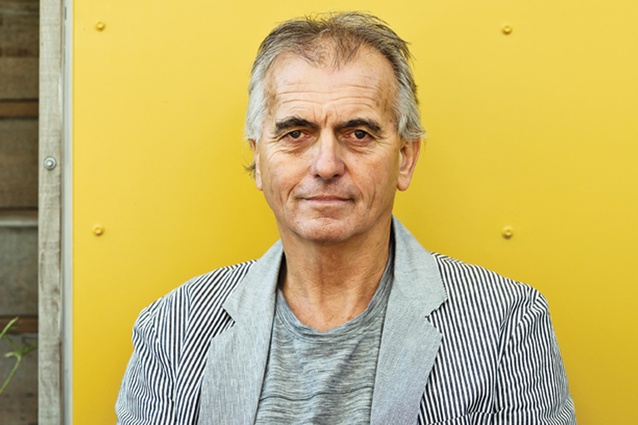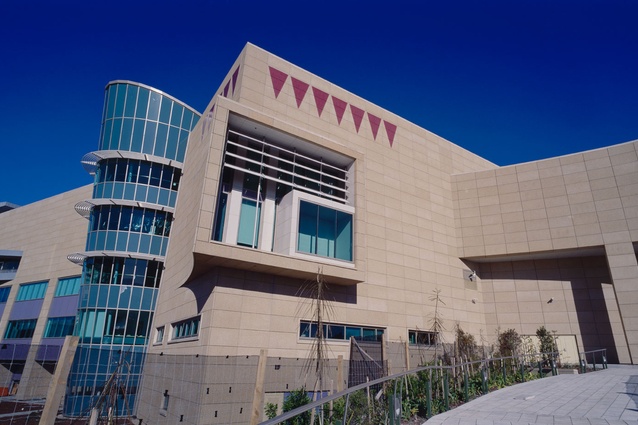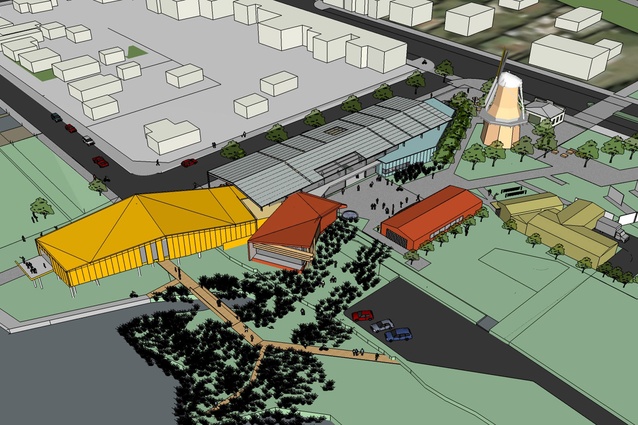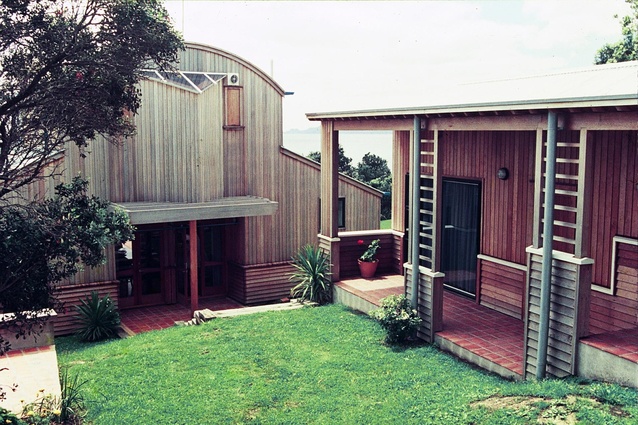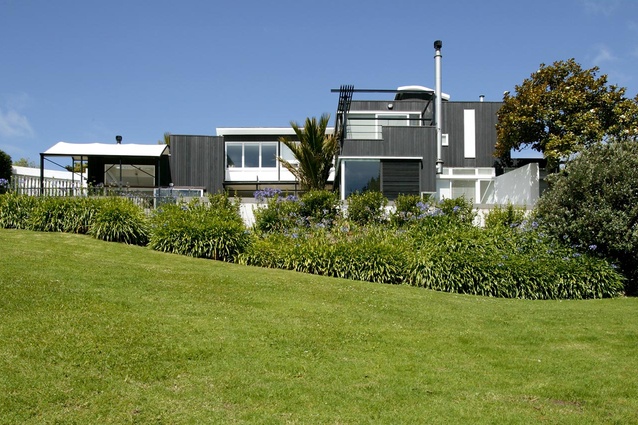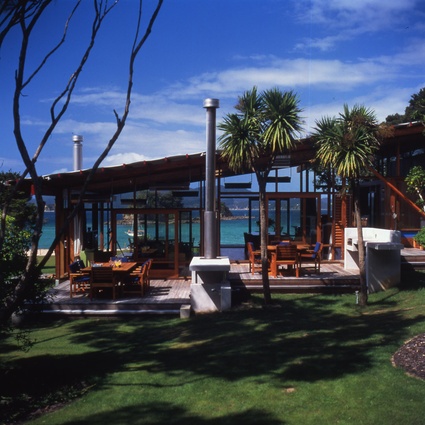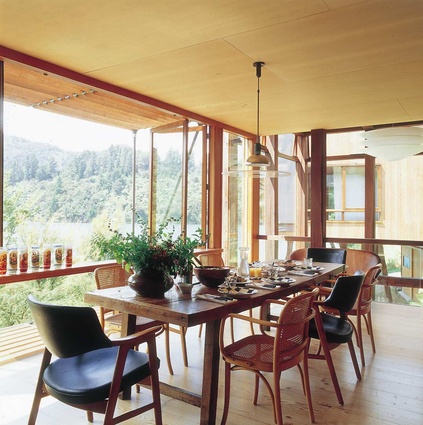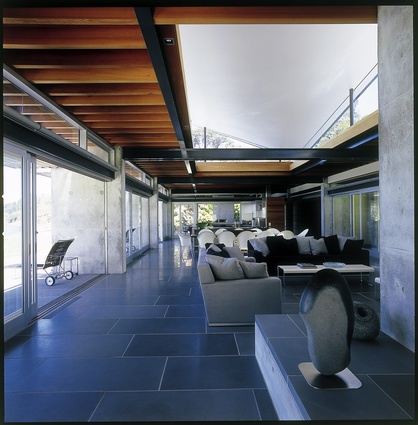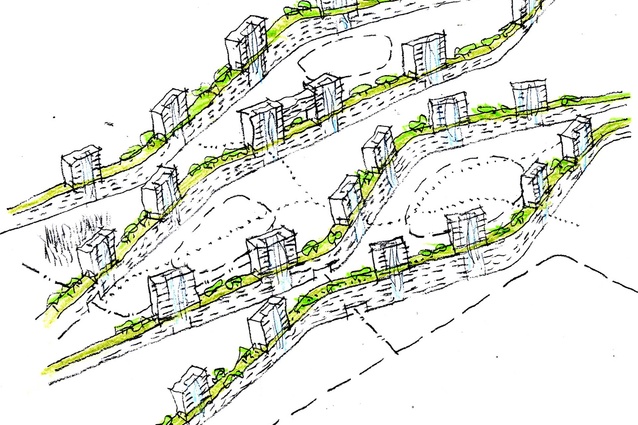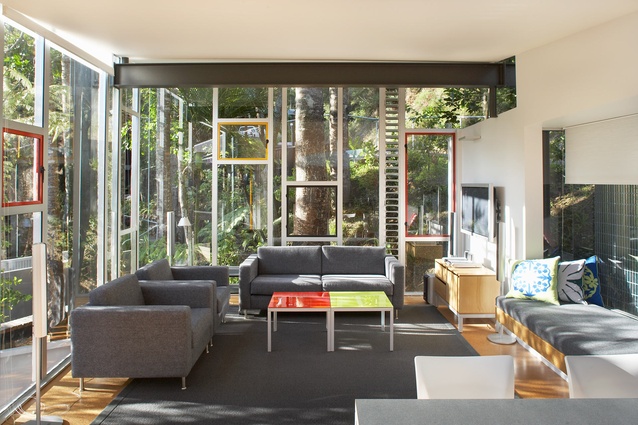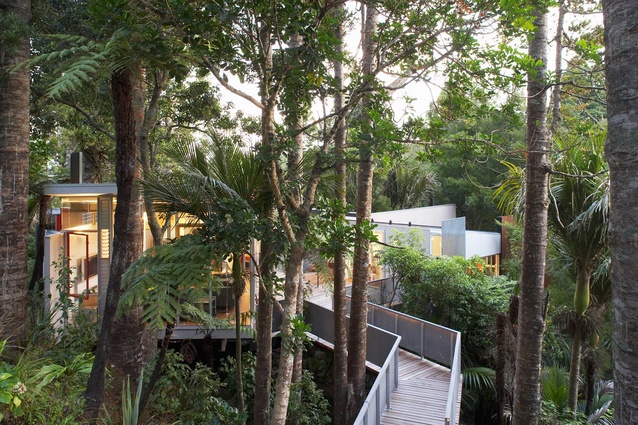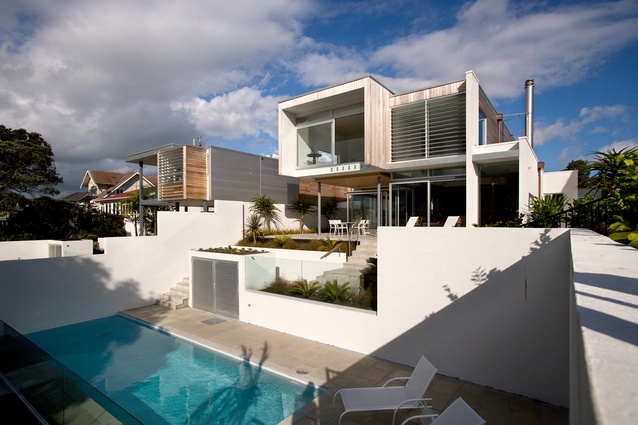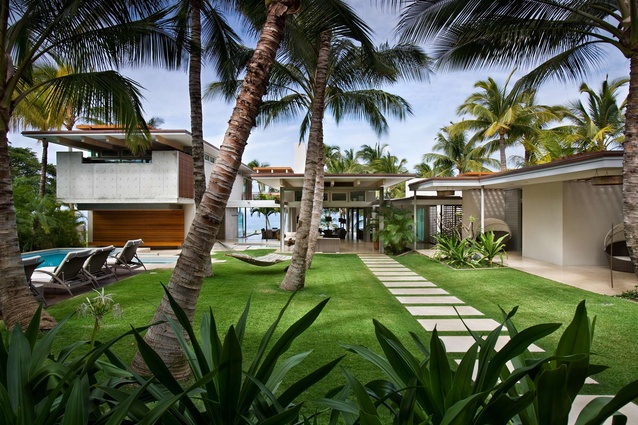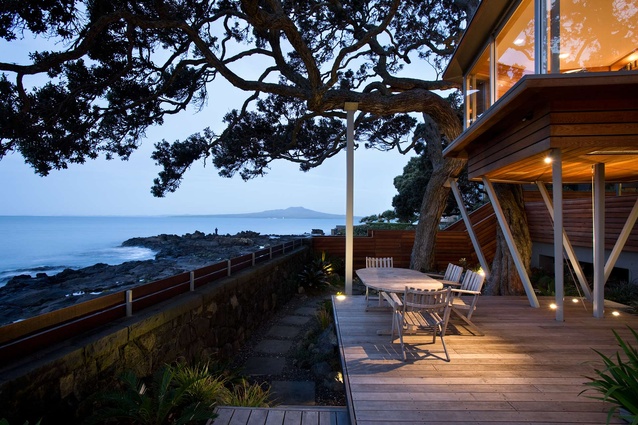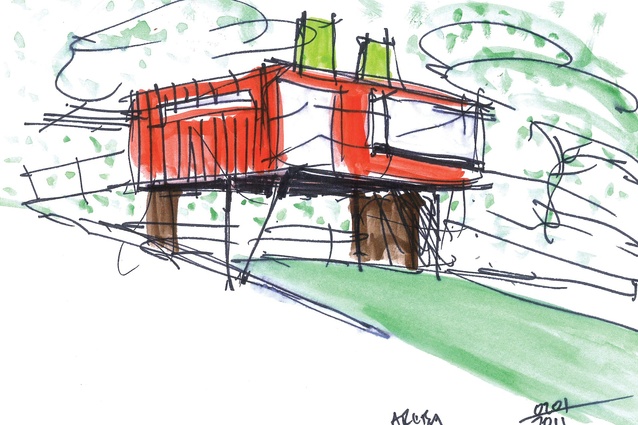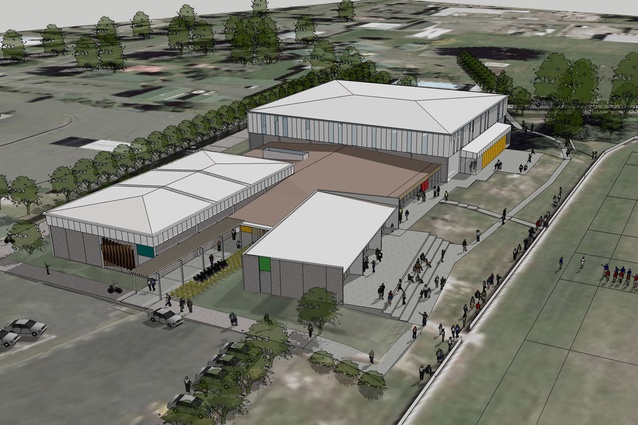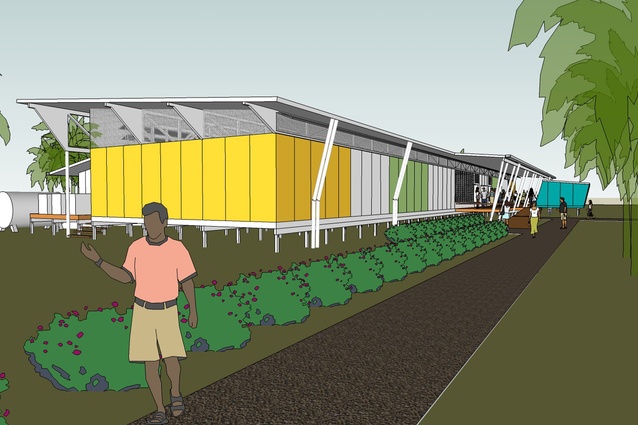NZIA Gold Medal winner: Pete Bossley
Justine Harvey talks to Pete Bossley, winner of the New Zealand Institute of Architects' Gold Medal for 2012.
Read the full interview below and scroll through the image gallery above.
Where are you originally from?
I was born in Nelson. When I was about 10 my parents, who were English, took me and my sister back ‘home’, as they called it, to the UK. My brothers and sisters are English.
Whereabouts in England did you stay?
We went to London. Then we travelled around for a few months in a motorised caravan which was fantastic, then we ended up back in London where I went to school for three months. We were away for just over a year, which was wonderful. It instilled in me a sense of fun and a love of travel because I was fascinated by it all. I have tried to travel a lot ever since and, of course, subsequently my travels have become focused on architecture.
Were there elements of your early upbringing that helped to instill in you a love of architecture and creativity. Are your parents creative?
Not really, they were involved in shops. I read books quite a lot but nothing particularly architectural. We moved to Christchurch when we came back from England and I went to Christchurch Boys’ High; the buildings at the school might have had an effect on me but I don’t recall anything in particular. I tossed up as to whether to be an architect or a lawyer and started at Law School and did the first couple of years of a BA LLB.
So, what made you realise that the law wasn’t for you?
I didn’t. I got sidetracked by Vietnam protests, the nuclear submarine protests and things like that, so the whole university thing felt less interesting. Then, my wife Margie became pregnant and that changed things quite quickly. Within a year or so, I actually ended up being a ditch digger and soon after that we had a child, Emma. So life changed enormously.
Literally you were a ditch digger? Yeah.
Fantastic. It’s always good to have an interesting profession at some point in your life…
I was driving a ditch digger for about five months. Then I got a job working as a trainee publisher – I was going to be a book publisher. But, then I met a draughtsman, which sounded interesting, so I made enquiries and enrolled in Wellington to do an NZCE Certificate in Draughting course by correspondence. It was tech drawing, building construction, stuff like that and I absolutely loved it. Studying at night and working all day, I managed to get into the third year of the five-year long NZCD (Arch) course and then at the same time I got a job at the Ministry of Works, which was great. I learnt a hell of a lot. The Ministry of Works was getting towards the end of its life. I guess it wasn’t their high period but I worked on Auckland Airport and other projects – doing all the toilets and stuff like that.
The important parts.
But, I was working with architects and realised that what I really wanted to be doing was what they were doing. It seemed like an even more interesting part of the construction business, so I looked into getting on the second year of a Bachelor of Architecture course. Well, that was just brilliant. I absolutely loved it… stressful in a way because by then we had two children and Margie was working. I had the children with me at University… in the creche. They used to come to studio classes and play; a lot of the other students who were there still remember babysitting my kids.
The school was okay with that?
Yeah, they were good in those days, more relaxed in a way. I absolutely loved architecture school and what I was exposed to there: great people, great staff. David Mitchell, Mike Austin and John Dickson were the main three for me.
So, what was it that they imparted? How did they inspire you?
I think it was an adventurous and very different approach to doing things. There were three sub-schools at the School of Architecture at the time. Three separate buildings: one was made of wood, one of steel and one of brick. The brick one was slightly removed and up at Elam rather than at the Architecture school. Mike and Dave were running it so it was the more adventurous of the three schools.
There was a strong sense that architecture had a social responsibility, which I’ve appreciated ever since. But also, that architects had a responsibility to explore other ways of doing things, to propose alternatives. Mike had the equivalent of psychotherapists – I don’t think they were called psychotherapists – but he had people coming in who would present different ways of looking at society than is normally seen through an architect’s eyes.
And, Mitchell was the natural-born teacher and extremely good at encouraging you to look at things from different viewpoints, to push yourself harder. John Dickson was a kind of inspirational lecturer and it was probably the first time I was really exposed to somebody who I considered to be brilliant. He was challenging to keep up with, but worth the effort.
So, you went to Law School, you were involved in protests and the anti-nuclear movement, there are obvious threads there – a sense of social justice perhaps? Was that part of your upbringing?
Yes, I think so. My parents weren’t rabidly political but they certainly thought that people should be allowed to believe what they believe. But, they didn’t go out of their way to actively change society so I think it was mainly just the time at the University. It was very open and exciting. Vietnam was obviously a big thing; there were big protests in Albert Park. Part of it was going out in boats to prevent the nuclear subs when they came in.
Worldwide changes happening too.
Yeah. But, I think that it was also in my architectural education. I became absolutely smitten with people like Louis Kahn and Le Corbusier. They believed that society could be improved with good architecture to a greater or lesser degree but I think that times have changed. I don’t think we now believe that if you do a better building then you produce a better society. They might have in the early days of modernism. But I certainly believe that if I do a better building that it can lift peoples’ spirits and that’s just crucial. And, obviously you can help society become a better society by helping it build a better society – build what it needs to. So, for me getting involved in things like the Fred Hollows Foundation, the clinics up in the islands, are important.
What is the Fred Hollows Foundation?
You know Fred Hollows the Kiwi eye surgeon who originally developed low-cost eye surgery for developing countries? We’ve designed a group of modular, flat-pack buildings to be made in New Zealand and assembled in the islands. We’ve also designed projects for lower income people and an organisation called The First Tee, which is helping provide buildings for an international foundation that encourages kids in lower social economic communities to get involved in sport, specifically golf.
Which islands?
Oh, various, it would depend. One of the biggest schemes we’ve designed contains a lot of clinics for testing peoples’ eyes and two surgeries for operations. It’s now at the fund raising stage. Fred Hollows is talking to our Government and the Australian Government. But at this stage, it’s a pro bono project so we’ll see. It’s all naturally ventilated so it’s as low energy as possible, with low operating expenses.
That must be really rewarding to work on?
Yes, but a lot of the public projects just take ages because money is tight, including some of the museum projects we’re doing. One is in Foxton but it will take five years probably. We still haven’t got it into resource consent.
What project is that?
It’s a complex with a public library, art gallery and the National Dutch Museum. It started with the Dutch Society, which is a trust.
Were there a lot of Dutch settlers around the Horowhenua?
Yeah, they had Luit Beiringer, a well-known Dutch curator in art museums, to do a study of New Zealand towns centres and also partly due to the enthusiasm of the local Council who were supportive, and for geographical reasons, being close to the state highway. There is also a large Dutch windmill there.
I travelled through there recently and got quite a surprise when I saw that.
We’ve had public workshops in the town and discovered that the history of flax is really important there, both to Pakeha and Maori. There had been 25 flax-producing factories in Foxton. It’s a real industry and, of course, for the Maori it’s really important for weaving kete and all sorts of things. So, we’ve come up with a strong architectural concept. It covers about 1,800m2 of public spaces.
So, going back to some of the earlier influences in your career, what about the influence of New Zealand architects?
I suppose, if anything, the weakness of the architecture school at that time was that it was fairly light on architectural history. But it was certainly strong on local recent history, mid-century onwards: John Scott, Christchurch, etc. I developed a strong belief that we shouldn’t be too parochial. I was really interested in international architecture and it was a time when ideas were flying around. So, for me the strongest thing was that architecture was better if it was driven by a good idea so finding that idea has become a driving generator for me. The other thing that has always been really interesting for me is whether the idea comes from within architecture, working with archetypes, or from outside architecture, using ideas that aren’t normally used to generate the form for a building. That’s been important for me with the fault line buildings that I’ve designed for clients, which also appeared in Te Papa – the idea of living in perilous lands and how that affects the basic diagram for a building. And, I’ve just designed a building based on a boiled lolly!
Which one’s that?
It’s our own bach at Orua Bay on the Awhiti Peninsula in the Manukau Harbour [Auckland]. Where did the boiled lolly originate? Well, the bach that we already had there was yellow and orange and a lady in a Auckland restaurant said to me one night, “Every time I walk along the beach, it just lifts my spirits. It reminds me of a boiled lolly.” I thought, great, I’ll do another one. So, we’re now doing a sleepout alongside – on stilts. It’s bright red with two green skylights rising out of the top of it, square and colourful like a boiled lolly.
Is it a guest house?
Yes, it’s a spare bedroom because there’s really only one bedroom in the existing place. The bedroom is up on top and below we can park boats.
I’ve been looking at your drawings as we talk – they’re beautiful. Drawing does seem like a dimishished art. It needs a resurgence, doesn’t it? When I interviewed Kerry Hill, his view was that the best architects have both the technical or computer-literate understanding and the drawing ability.
It’s certainly a hobby-horse of mine. I do believe that people who can actually draw, can explore spaces much quicker than people who rely on computers.
It must develop your spatial awareness.
I didn’t really start to draw until architecture school. I remember an art teacher at school wanting me to pursue art courses at high school but my parents advised me against it because I wouldn’t get a job. When I went through the draughting course, my sketches were quite technical drawings or descriptive. That didn’t change until I was about 30 when I spent a year hitchhiking through Europe. In 1980, I went to Greece and Italy and then Turkey. My sketching was transformed in Turkey – it was just amazing.
Because of the colours and the light?
It was the openness of it and the vastness of it. I’d travelled for a few weeks with a Swedish woman who was an artist and could draw really well. There was a desire to sort of draw space and the feeling of the space, rather than the objects they were creating. I moved away from realism and started trying to capture atmosphere.
And, after architecture school?
When I left architecture school, I worked for the Ministry of Works for a couple of years and then I hooked up with Pip Cheshire, Mal Bartlett and Amanda Reynolds. We each had our own company and we had our umbrella group called Artifice Studios.
So you were doing your own schemes?
We were doing lots of alterations but we started getting some interesting work. Even then, we were interested in doing work that we felt would measure up internationally, in terms of the ideas that were driving it. It’s not good enough just to be good in New Zealand, you have to measure it against what’s happening internationally and I think the work that’s being done here is really good. I often lecture overseas and people are amazed. So, I think we underestimate how good New Zealand architecture can be.
What were the key projects you built in the early days?
Mainly all houses.
Which ones stand out the most for you? The first big one for me was Craig Heatley’s house in St. Heliers, Auckland.
You built a lot of houses for the Heatley’s, how many have you built for them?
I think I’ve designed 10 and six have been built. It’s must be wonderful to have a client who keeps coming back? Yes, and the idea for that particular house worked for subsequent clients and I’m now working on that house again. It was the first one that had the idea of a fault line going through the building. So, it’s got this wall that splits the building in both directions, horizontally and vertically. I’d been thinking about what it means to live on top of fault lines. That was about trying to express an idea through the architecture so it’s nothing to do with archetype. It’s just an idea, which has generated an architectural form and has then taken off in all sorts of ways. The other one I explore repeatedly is a different approach: the idea of encampments is quite a good one for me.
What does that mean?
The holiday places. It’s pulling spaces apart into separate buildings, rather than just as a simple house, so that when you’re living there, there’s more of a relationship to the outdoors. It’s like setting up a camping ground. I’m planning a book on the subject.
It seems to me that New Zealanders would respond well to that. Obviously we have the weather to respond to it as well. This idea of separate adjoined buildings reminds me of one of Rogers & Fosters’ very early houses, a place called Creek Vean, built for Roger’s parents, I think. It’s in Cornwall.
The one with the path that goes down over it? It’s got a glass corridor between the two buildings and it’s interesting.
Yeah, the owner had a hard time selling it last year; it was probably expensive for a remote location and you would have to know about architecture to fully appreciate its true value. In England it must have been radical at the time it was built, especially where it is located. But, this typology of separating/linking buildings, coupled with the outdoor lifestyle and the history of the bach, is more fitting to New Zealand, isn’t it?
It goes back to the idea of camping and to the idea of garrisons, of military camps. Then it leads to the comparison between the courtyard house as a Persian symbol of paradise and also Asian/Chinese houses, a solid courtyard house. The house we designed in Hawaii and the houses up the Bay of Islands have broken that courtyard open but so it’s all about playing with the delicate balance between what is enough enclosure and what is too much enclosure.
Depending on the winds…
Well, exactly and the contours, working with the land but also the attitudes of New Zealanders. We like to live near the sea.
We also like to have our privacy.
So, it’s a balance between all those things but I think it is different from what you might be able to do in many other cultures. What it means is that the spaces between the buildings become really important too.
It’s a really good idea for a book – it typifies a lot of what New Zealand housing aspires to.
And, the attitude to the land. I mean, I turned down a job recently. It’s a $20 million project in a beautiful bay so it took a bit of turning down. But, we had a design for the building and the client just wanted a big white blob and we felt it would be offensive.
Not what New Zealand needs.
Not what the bay needs.
If there are subtle bachs and buildings all tucked away in the bush, then you don’t want to ruin that atmosphere.
So, I said ‘no we’re not doing it’ and now somebody else has done it.
Such a shame. changing the subject but you don’t seem too concerned about maintaining a style as such.
We tell our clients that with some architects you know what you will get in advance. It’s like buying a BMW. But, with us, you don’t. It’s a bit scary and takes a bit of investigation in terms of what’s possible and there can be a fair bit of spiraling around but its more fun.
I suppose keeping your office quite small is probably a good way of maintaining that kind of approach because as you get bigger it gets harder to work like that doesn’t it? Well it is but I always say, if you’re engaging a big office you rarely get 15 people working on a project anyway.
But it’s that big expectation isn’t it, in terms of process?
Yeah, very much. I am involved in all the projects but we do try to limit the number we do at any one time to give clients a fair amount of attention.
Let’s go back to talking about your first practice.
Pip [Cheshire] and I formed Bossley Cheshire Architects and that was great. We had a full-on few years and really enjoyed working together. Then we were approached by Jasmad and joined up with them, and with Gibbs Harris we formed Jasmax. That was great, I really enjoyed it. The first thing we really did was the competition for Te Papa and won it. Loved it. And that kept me busy for the next seven years, I suppose.
That would have been a much bigger scale than you’d previously worked on.
Yeah but that was the chance of a lifetime really. And, I was working with Ivan Mercep and all the guys at Jasmax, which was fantastic. And, I designed the Parnell Post Office and some other projects but in the main, Te Papa took up most of that time.
Looking back, how do you feel about it now?
I’m proud of it, it’s great and the fact that the public love it and use it a lot. I left Jasmax just before Te Papa was finished. But I was asked to go back and do the Treaty of Waitangi exhibition which was a really exciting project. And I worked with Paul Thompson and Haniko te Kupara. The centre space of the building was based on the idea of a wedge of space between the two offset grids of the building, one of which follows the traditions of Maori marae layout, while the other follows the European land use which echoes the grid of Wellington. In between is a triangle based on the idea of ‘cleave’, one of those few words which contains opposite meaning – to separate and also to bring together. So, we did this great exhibition that told the story about the differences between the Maori version and the English version and also the problems that the treaty had caused over the years and the benefits it afforded. It was a really nice thing to work on.
Subsequently, I’ve gone back and added a café because the place was so successful it was immediately overloaded. Then later on, we put in the new galleries that were required. It’s designed with a really adventurous and bold museological premise and it got a fair bit of flack from the art community because of that. But, its new galleries were installed quicker than planned as a result, which is good.
I don’t think people necessarily realise this but it was incredibly brave. It was set up on the basis of doing an interpretive museum when the rest of the world had only ever really done interpretive shows. Nobody had built a whole museum based on the notions that Te Papa was trying to achieve. Having worked with some international exhibition designers on it, they said the world was watching Te Papa because it was breaking new ground. And, it’s interesting to see other museums do it now; there was the Jewish Museum in Berlin etc. So, it was a really exciting project to work on.
It must have helped with winning new work afterwards?
Well, it would have done, for Jasmax especially, but I had left before completion as I had this notion about painting because I’ve always liked painting but I hadn’t had any time for it. I didn’t want to retire one day, start painting and say ‘shit I wish I’d have done this 20 years ago’. So, I thought I’d see what happens. I left Jasmax, went home and worked on my own for a while and painted. That was great, then I was joined by James Downey, who worked for me for seven or eight years. And the architecture started to grow again, I started to employ more people and I sort of realised that I love painting but architecture is my predominant passion. The paintings are there and I’ve got a studio out the back that I can potter around in occasionally but I’m happy about that. I don’t sort of feel as though I haven’t given it a chance.
You’ve got it out of your system.
Yes and then other people started joining us and we outgrew the house. We’re now back up to 15 people who are great people.
You’ve talked before about more critique needed in architecture – do you still agree with that, in New Zealand particularly?
I think it’s good for the dialogue, it’s got to be good for architecture and for practitioners as well, so it’s not seen as something personal that you get upset about but it’s an interesting debate that we had. One of the great things about architecture in this country is that it’s a really collegial profession and that’s unbelievably important. It would be a shame to lose that, as it’s really important. So, it would be nice to ensure that more critique happened without destroying friendships or diminishing that collegial atmosphere.
I remember seeing the ‘Voyager’ Maritime Museum before I knew it was your project and really enjoying the light colours and the way they respond to the neighbouring harbour and the sky. They’re like watercolours, which work on lots of different levels. It’s bold but blends in at the same time.
On a misty day you can hardly see it but other days it’s really crystal clear. Designing a Maritime Museum, I didn’t want to reach for the obvious thing of doing a building that looked like a boat. The team talked about it and thought about these boats and the environment they want to be in themselves – the water that’s constantly shifting, the swirls, the winds and the light that’s changing all the time. I’ve got a whole series of photos that look at the yachts; the light coming through the sails, the light going into the water and bouncing back out again. It had an ephemeral kind of quality to it. It changes all the time. And, at night, its like the biggest light box in the country.
Now, what about the Colin McCahon Artist’s Residence. That’s been an important project for you, hasn’t it?
It’s sensitive because you have to relate to the existing cottage. I think we won that interview process because we pointed out that we wanted to respect the cottage and that we didn’t want the new building to be buried under the weight of McCahon’s reputation. We wanted to give the artist residents freedom to keep their own direction. So, the building does actually bend away, it gives the little cottage room to breathe but it’s also got its own identity; it’s designed like a series of abstract planes in the trees.
Formlessness is an idea that interests me. Looking at the perilous land forms which leave irregular buildings. We have these incredibly powerful forces in this country but we largely ignore it. Te Papa’s got a fault line running through it, it’s within an actual fault line. Then, there is a piece I did for an exhibition in Tokyo, an acrylic cube partly filled with black sand and a small timber structure. You pick it up, roll it over and the structure rumbles round in the sand.
We also did a big scheme at Shanghai that creates striations of land form and spaces between them, and these rise and fall and come apart. Then in between them, you can live under the land and walk above and then towers grow out of the top of it. Openness has always been a big thing for me and creating comfort because I’m so sick of houses that look good in magazines but aren’t comfortable to live in.
But, it strikes me that you’re not someone who thinks New Zealand architecture should be a certain way, that you’d want to prescribe anything in particular?
I think things do define aspects of New Zealand life but it’s rich and doesn’t deserve to be boxed in by some definition of what it is. But, to some extent we have done that because there’s been a governmental desire to define New Zealand for quite some time but I think we might be getting through it, I don’t know. Again, it’s all about context.
What’s with the spy ball project?
We designed this project in the Marlborough Sounds in the Spy Valley. There are these two spy balls that all the locals are very wary of. Apparently the CIA runs it and everyone is really nervous so I designed a house that I wanted to lift up out of the surrounding vineyard, so it didn’t get enclosed by the grapes.
What are the spy balls?
They’re just telecommunications. Nobody knew because they looked like big inflatable membranes and it was really hard to know what was inside. Someone broke in and actually sliced it open and it turned out there were big satellite dishes inside. So, our building is the observer observing, spying on the spies.
What other projects are you working on at the moment?
Another project that’s under construction is a sports and events centre in Tokoroa, which is important for the community. It’s going to be finished at the end of the year. Also, we’re building houses in this country, America, and the South of France; interior projects at the Auckland Museum, mixed-use and masterplanning projects. And, there’s also a 150m-long footbridge we recently completed in Raglan, with exciting colours which light up at night.
So, all in all, you’ve had a fascinating career?
It’s all been very wonderful. I can’t think of a better way to spend over two thirds of a life.

